As an Amazon Associate I earn from qualifying purchases.
Brining olives is the oldest way to cure olives, especially green ones. What follows are instructions and troubleshooting on how to cure olives with a brine. There are other ways I’ll get to below.
This post assumes you have access to fresh, green olives off the tree, which are pretty but inedible — they are impossibly astringent. Olive trees can be found all over California, in many parts of Arizona, as well as Australia and, obviously, the Mediterranean, where they are native.
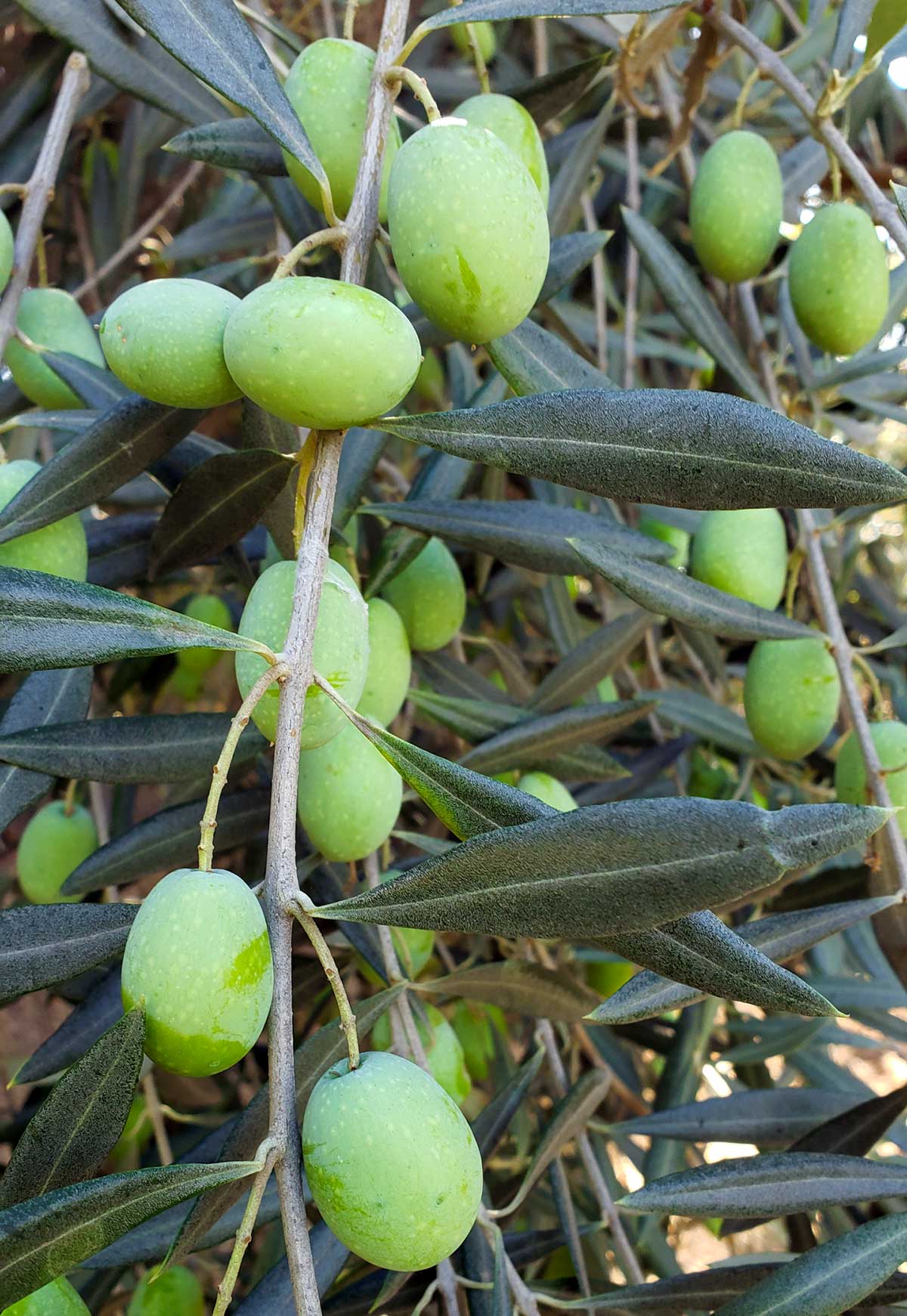
You can buy fresh olives online, and over the years I have provided links, but these companies seem to come and go quickly, so I don’t do that anymore. Just Google “buy fresh olives” around September here in the United States, and I think March in Australia.
The timing is important because you want fresh green olives. And yes, like peppers, all olives start green and ripen to another color, usually black in the case of olives.
Green, unripe olives are firmer and way more astringent than ripe ones. Brining olives when they are green is a great way to cure them, and green olives are the only olives suitable for what, admittedly, is my favorite cure, which a lye cured olive. That process, believe it or not, has been used for 2000 years, and is not as scary as it sounds.
You can brine ripe, black olives, too, just so you know.
My general rhythm is to cruise my local parks in late September or early October; they are full of olive trees, remnants of pre-suburbia orchards around here. On some crisp autumn Saturday, I go picking. Look for pretty olives, with few or no blemishes, and which are not wrinkled.
Tiny dots on an olive are OK, but many may be rotten with olive fly, whose larvae burrow into olives and leave a beige scar where they entered. that telltale scar means there is a visitor lurking within your olive.
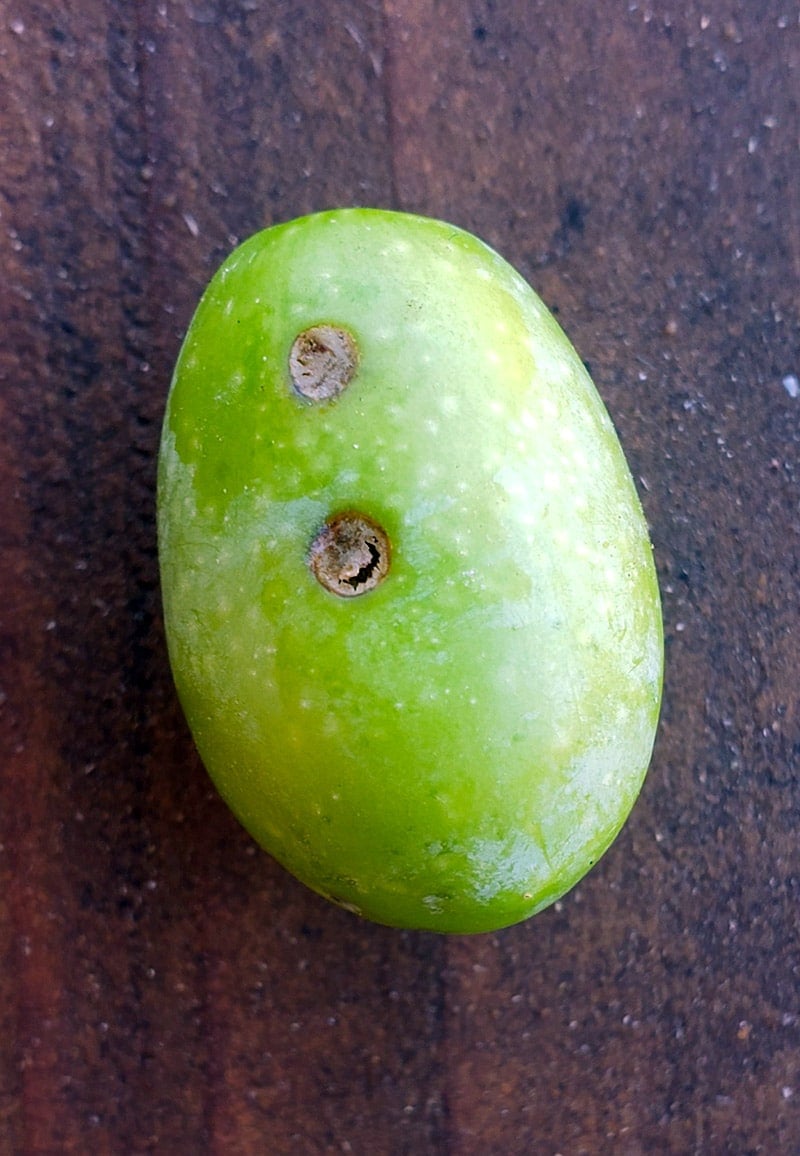
Another hazard are the dry olives. Trees forced to live by their own wits — away from regularly watered grass — are stressed, and their olives shrivel early. Shriveled olives are usable, but they bruise rapidly and don’t make a clean green olive.
When you get home, separate your olives into small, medium and large olives — it doesn’t matter what variety they are, as I don’t know how to tell the difference. If you don’t have enough large ones to make its own batch, mix them with the mediums.
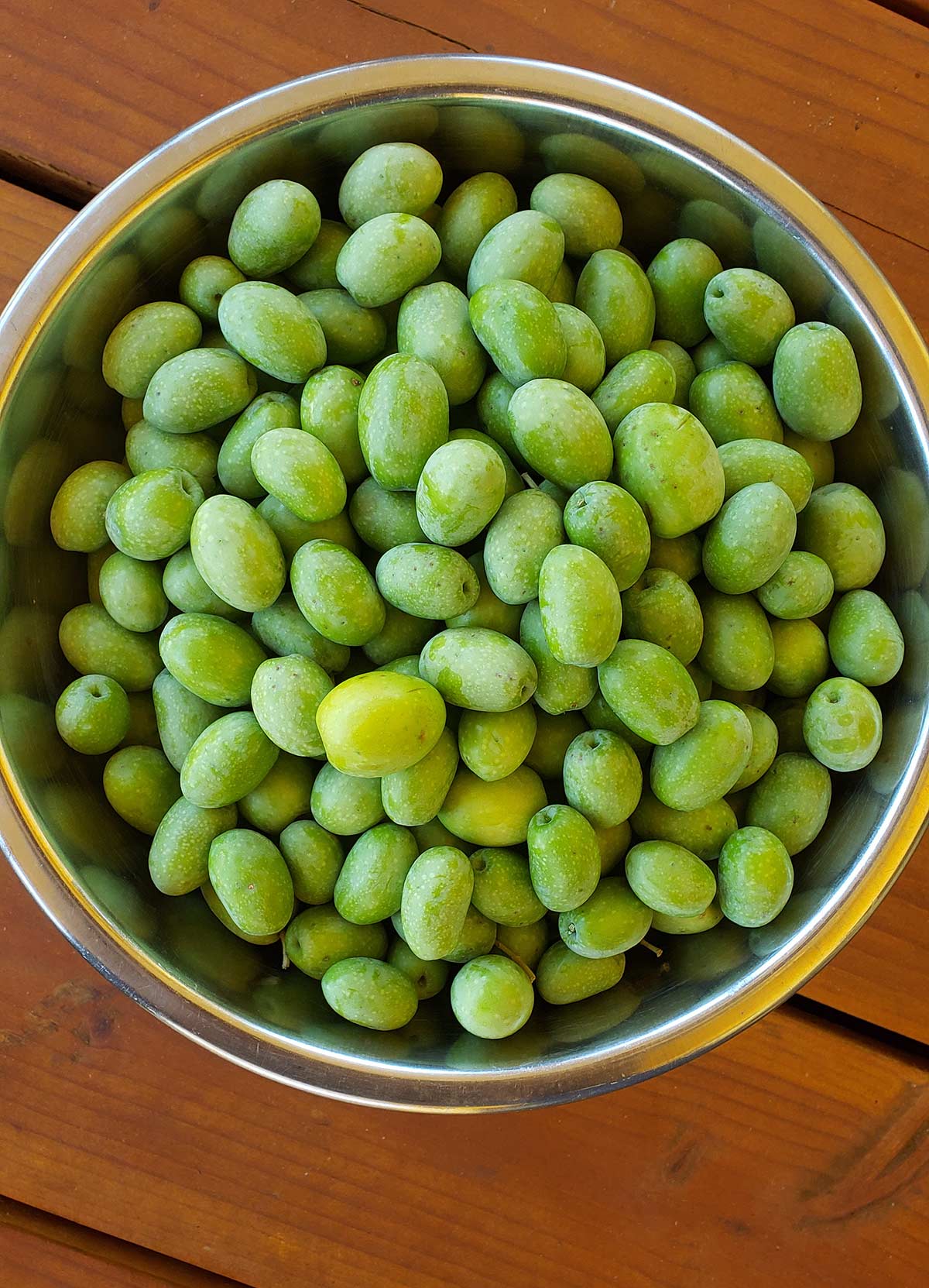
Unless I am doing the lye cure, brining olives is my preferred method, as it is low-maintenance and results in a super-tangy, salty olive that keeps for more than a year and cries out for beer or ouzo. And I like ouzo. A lot.
Brine-curing is easy, but takes a long time. You make a brine of 1/4 cup kosher salt (I use Diamond Crystal) to 4 cups water, plus 1/2 cup of vinegar: white wine, cider or simple white vinegar. Submerge the olives in this brine and top with cheesecloth or something else to keep them underwater. Do not cut them.
Cover the top of the container loosely (I use large, 1 gallon glass jars) and put the jar in a dark, cool place. That’s it. Check it from time to time — meaning every week or so at first. The brine should darken, and you might get a scum on the top. That’s OK.
What’s going on is that your olives are fermenting; it is the fermentation that breaks down the oleuropein over time. The what? Yeah, oleuropein is the astringent substance in an unripe olive. It needs to go if you are going to eat one. Fermentation is why I never wash my olives before curing — I want those natural yeasts on the outside of the olive to do their magic.
I change my brine every month or two, when it begins to look extra nasty. I don’t re-rinse the olives, during changes, either, because I want the residue to act as a “starter” to get the next batch of brine going.
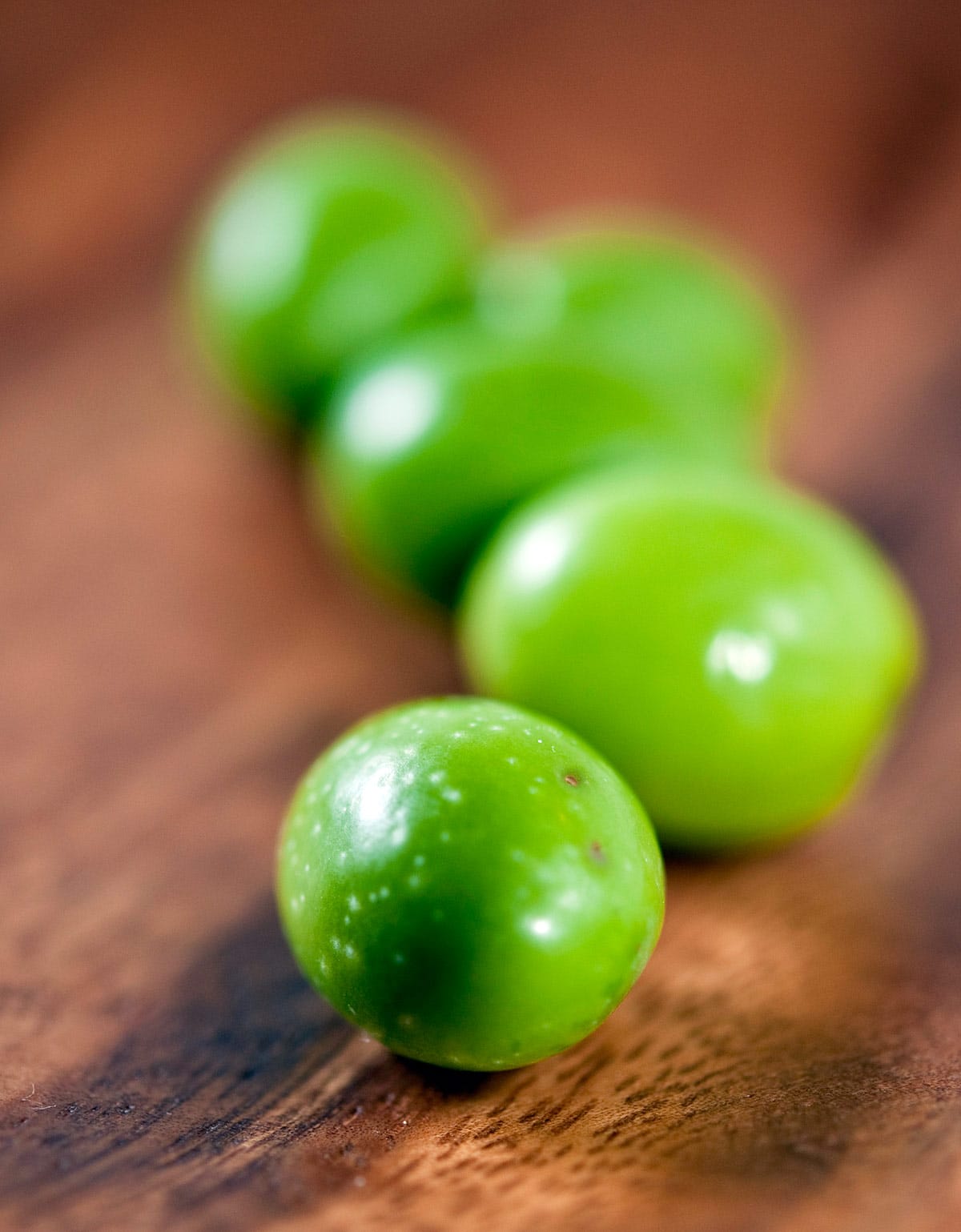
Keep in mind you will be in for the long haul: Olives picked in October are typically ready to eat in May or June. It’s a lot like making wine.
Add seasonings after the New Year, or even later, otherwise you risk too much spice and not enough olive flavor; this is especially true of chiles. If you find you’ve gone too far, change the brine and don’t add new seasonings, and let it steep for a few weeks. That should calm things down a bit.
Once the olives are finished, there is a certain show-off factor when you pull out a plate of olives you cured yourself. “These are your olives? Wow.” Plus, you can flavor them any way you like, which is a bonus.
If you’re too late for green olives, I really like salt cured black olives, which we all call oil-cured olives since that’s how they are stored. If you want to cure black olives, my method is to oil-cure olives.
Brine Cured Green Olives
Ingredients
- 4 pounds fresh green olives
- 1 cup kosher salt
- 1 gallon water
- 1 cup distilled vinegar
Instructions
- Assuming you've already checked your olives for worm scars (see headnotes), discard any with too many blemishes. Place the olives in a stoneware crock or large glass jar with a lid carefully. Fresh olives actually do bruise easily.
- Mix the vinegar, salt and water together. No need to boil, as it will dissolve at room temperature. Pour this over the olives, making sure they are submerged by at least 2 inches. Add more brine in the same ratio if need be.
- Chances are the olives will float. You need to keep them away from air, so I put a plate over them that is just about the size of the jar or crock. You can also use a plastic bag filled with water to keep the olives away from air. Once the olives are submerged, cover the jar or lid (lightly screw on the top if there is one) and place the container in a cool, dark place. A basement is ideal. You don't want them to ever get beyond 75°F if you can help it, because at higher temperatures the olives can go soft. Since this is a wintertime cure, it should not be a problem. Low temperatures are fine, just don't let them freeze. Let them sit for several months.
- As time passes, you will see a scum of mold and weirdness form on the top. This is normal. Skim it off once a week and you'll be fine. At some point the brine itself will get pretty icky. I like to change the brine every month or so, but this is not strictly needed. The olives are done when they are no longer bitter, anywhere from 2 to 4 months.
- Only now do you add other seasonings, like chile peppers, black peppercorns, herbs or citrus peel. Do this in a fresh brine, and let this new, flavorful brine sit 2 weeks before serving. Store the olives in this brine, in a cool place or refrigerator, for up to 2 years. I keep them in quart Mason jars.
Notes
Flavor Additions
- dried chiles
- bay leaves or similar aromatic leaves like citrus leaves
- thyme, sage, oregano, rosemary
- allspice, black peppercorns, juniper berries
- smashed garlic cloves
Nutrition
Nutrition information is automatically calculated, so should only be used as an approximation.

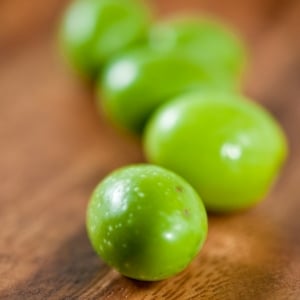




Hank, you are amazing. I just love the fact that you find things most people take for granted (olive trees) and make something delicious of of them. I am so going to try this! Any olive groves you know of in the Land Park area? I’m too late for green, but maybe black…
David: No, I don’t slice the brine cured olives. I like them whole. It probably would speed the curing process, but I like uncut olives for that preparation.
Do you slice the brine cured olives too at the start? Or only the water cure? I’ve seen brining recipes suggesting either way (though seems like the slice reduces the brining time a lot). Thanks!
Last year I tried my first effort of curing black olives. I washed them and placed them in an old stone crock. I simply covered them with layers of sea salt (no water). I found that kosher had little effect. I did not slice the olives. I left them just as I picked them from the tree. I stirred them every couple of weeks, and changed the salt once in three months. After three months I began to sample them every week until I got a flavor I liked. In total it took about four months, after which I dipped them in boiling water and left them to dry over night before placing them in jars of olive oil, vinegar, thyme, garlic and a slice of lemon. They stored nicely in the refrigerator and were absolutely delicious. I just picked a another batch today and have them in the sea salt ready for a their hibernation.
Ok, one more question. When doing the brine, should I put all the spices in a cheesecloth or just let them float around with the olives?
Thanks Hank-
things are going swimmingly! The brown area from the knife cut has morphed into green – will taste them every week and test PH also. Will also change brine monthly as you suggested. Get the feeling that there are many ways of doing this. Going to do a brine for some black olives as soon as I can get some.This is fun!
Jovi: Yes, perfectly normal.
Linda: I switched out the water time because they were still too bitter for me. Peter from the Kalofagas blog (he’s Greek), suggested a month, and as it is now officially a month, I can say my olives are no longer bitter — so Peter’s advice was sound.
Brining will pull out the rest of the bitterness over time. Keep them in brine and change it every month. Taste your olives and they should be good to go by Christmas.
Almost time for black olives! I go in December…
Hi Hank
I cured two batches -one using your recipe with kosher salt and one using Maurice Penna’s suggested recipe. I called him and he gave me salt quantities by weight-not volune and I made the recipe using pickling salt (heavier than Kosher salt). It’s been a week now and I tasted both batches – the olives seem a little bitter. Hank I noticed that you changed the water soaking time above from 2 weeks to one month-wondering if I should put them back in water for another 2 weeks or if the brining will pull out the bitterness if I change the brine as you suggest. I didn’t notice a difference in taste kosher vs pickling salt but there is a slight difference in the PH level after a week. I think that the PH will continue to change as the olives cure. I added fennel and bay leaf to the brine and will add dry garlic later.
I’m hoping to do a batch of black olives soon as well using the brine method.
I put my olives into the water cure 11 days ago and they’re half brown/olive green as well. I’m assuming this is normal and waiting the full 2 weeks to taste one. I agree with Linda though that they start “browning” by the slit first. Is it normal?
Linda: Sorry for the late reply, but the sort version is they should be fine. My water-cured olives always turn “olive” instead of that pretty green. Have your olives lost their bitterness yet?
Holly: You can do that brine cure on the black olives just fine. The different taste is probably fermentation — is it a tang? You can lye-cure black olives, too, but I haven’t done it yet.
Hi
We planted 7 olive trees, 3 are 3 year old and 4 are 1 year old. We tried salt water brining last year on about a pint and they never tasted right. We just picked about 3 times as many black little olives today. Anyone have suggestions for what to try this time?
Hi Hank -Linda again
So I cut a slit in my green olives and they’ve been soaking in water since Saturday. The slit has turned brown on all of the olives and there are brown spots developing on some of them. Can they still be cured in brine or are they spoiling?
The only reasons I can come up with for the browning are I cut the slit using a Kuhn Rikon knife (carbon steel blade) and I used tap water. I think I may put half of the batch in a brine now and continue the water leaching with the rest.
Any ideas?
I get my fresh olives shipped from Penna in Orland, CA – GreatOlives.com I’ve always done ripe (black) olives, but he sold only green olives this year – hence my search of your site looking for guidance. I do the water method, changing it every day. I was away from home for a week, so for that week I added salt (kosher, enough so a raw egg in shell floats), then switched back to daily water changes when I got back. Today, my olives are ready to cure. I’m going to try: vinegar, garlic, lemons, red bell pepper and oregano. Any other ideas???
Thank you for the wonderful and useful post!
It’s becoming my California tradition too.
I brine-cured some black olives last year, they did take forever, but they came out very tasty.
I just picked up a few pounds of green olives in the local park, and I am going to use your water method on them.
I hope for some black olives later on, but with these early storms that knock them to the ground they may never have a chance to ripen.
Linda: I use kosher salt so my measurements are the same as yours. It is free of any addititves, and by mentioning the kind of salt, my 1/4 cup of salt to the brine is the same as yours — if you’d used fine-grain salt you would have too much in your brine.
I use glass containers. Go to an Asian market and look for Korean kim chee jars.
Never heard of botulism with olives. I’ll look into it.
Hey Hank
I just bought a bag of green olives from an Italian deli here in Vancouver and will start brining shortly. What kind of container is best?Would a plastic bucket be safe and inert or should I try to find large glass jars. I have some old stoneware Chinese pickled vegetable pots in my garden I could also use but they would require a lot of cleaning inside..
This is exciting-have been talking about doing this for years. Some recipes call for pickling salt but you used Kosher-aside from texture what is the difference? Is there a risk of botulism if the curing is done incorrectly?
Thanks
You super smart Californians! I don’t think I can get green olives here in Toronto though I would love to experiment like you do.
Ohhhh, yum. I used to work for Graber Olive House and the pleasure of eating those buttery lye-cured olives whenever I wanted is one of the great memories of my life. There’s a house in my neighborhood with a fruiting tree; I should walk over there and see if it isn’t too late to harvest it.
I grew up with an olive tree in my front yard… I always wanted to make them edible, but no one knew how… That poor tree (which also had my tree house in it) has long been cut down (I actually cried that day) but I think I might like to go forage some around Carmichael towards December, I am trying to remember if anyone I know has a tree or two…
Terrific post, Hank!
I’ve got some olives in water, changing a couple of times a day – but they seem to be oxidizing. Anywhere there was a blemish (or along the cut-line from my knife), they’re turning brown. Is this normal? Should I toss them and start again?
Thanks for the guidance!
Jenny